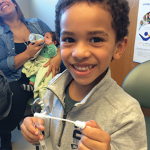
SAN DIEGO—When the late pediatric rheumatologist Suzanne Bowyer, MD, was at the height of her career some 25 years ago, there were few options to treat children with rheumatic diseases. There were critical shortages of pediatric rheumatologists and clinical trials and no patient registry from which to collect and analyze data to help clinicians treat their patients effectively.
As a result, patient outcomes were poor. One of Dr. Bowyer’s early studies showed that almost half of patients with systemic juvenile idiopathic arthritis (JIA) had significant joint damage five years after diagnosis. To improve those outcomes, pervasive intervention was needed to create a more effective framework for research and treatment.
Today, the future of the field is much brighter due to the leadership of Dr. Bowyer, said speakers at the Rheumatology Research Foundation Memorial Lecture, “Pediatric Rheumatology: Where We’ve Been, Where We’re Going,” which took place at the at the 2013 ACR/ARHP Annual Meeting, held October 26–30. [Editor’s Note: This session was recorded and is available via ACR SessionSelect at www.rheumatology.org.]
Serious Threats to Survival
The dire workforce shortage spurred Dr. Bowyer and others to develop the ACR’s pediatric rheumatology award to attract fellows to the field, said Andrew Lasky, MD, Dr. Bowyer’s first fellow and a pediatric rheumatologist at Randall Children’s Hospital at Legacy Health Systems in Portland, Ore. Dr. Bowyer, who spent the bulk of her career at the Riley Hospital for Children in Indianapolis, also helped develop the first pediatric rheumatology registry, the Childhood Arthritis and Rheumatology Research Alliance (CARRA). The first abstract based on CARRA research was published in 2002, and more studies flourish today.
Dr. Bowyer was driven by her desire to improve the lives of her young patients, said Dr. Lasky. “Her patients and their families loved Sue, and they felt her commitment. They knew she would do everything she could to make them feel better.”
Pediatric rheumatology faced serious threats to its survival when Dr. Bowyer launched her efforts, said Christy Sandborg, MD, service chief of rheumatology at Lucille Packard Children’s Hospital at Stanford University, Palo Alto, Calif. In the late 1990s, only 13 U.S. medical schools had more than three pediatric rheumatology fellows. Almost one half of medical schools had no fellows in this field, Dr. Sandborg noted.
“Academic productivity was compromised by the clinical load and by the lack of infrastructure. The American Board of Pediatrics even considered dropping pediatric rheumatology altogether,” she said. The ACR intervened to help grow the number of pediatric rheumatology fellows and also created the ACR/Amgen Visiting Professor in Pediatric Rheumatology program. The ACR also created the Amgen and Paula de Merieux Clinician Scholar Awards, which helped fund travel for fellows to the ACR Annual Meeting. The National Institutes of Health (NIH) also launched a loan repayment program to help fellows, Dr. Sandborg said. As a result of these interventions, there are currently 312 board-certified pediatric rheumatologists and 90 fellows-in-training, she added.
There are still serious workforce shortages, Dr. Sandborg warned. Ten states in 2012 had no board-certified pediatric rheumatologists, and 40% of pediatric training programs do not have a pediatric rheumatology program, she noted. A number of states, especially in the West, are severely understaffed. “There are barriers that we are still continuing to address. The clinical burden still distracts from the research focus,” she said.
Research Collaboration
Pediatric rheumatology investigators needed an inclusive platform to collaborate on research studies and network, said Dr. Sandborg. After a summit meeting in 2000, a team of pediatric rheumatologists conceived the CARRA registry, basing it on a successful children’s cancer registry. Goals were not only to improve the academic standing of pediatric rheumatology, but “to improve outcomes and the quality of life for children with rheumatic diseases, and to drive funding,” said Dr. Sandborg.
CARRA’s guiding principles included a scientific agenda set by the members, not by drug companies or other bodies, she said. The research has to be of high scientific merit and translational, and there must be transparency, she noted. CARRA currently has 394 members at 107 institutions and is aided by funding from the Arthritis Foundation.
Four major CARRA clinical trials are now flourishing, Dr. Sandborg said. These include the APPLE trial, which looks at whether or not atorvastatin reduces carotid atherosclerosis in pediatric systemic lupus erythematosus, and the 12-month Trial of Early Aggressive Therapy, or TREAT, investigating 86 children with polyarticular JIA and funded by the NIH. Initial results of TREAT show that early, aggressive therapy resulted in clinically inactive disease in six months, and clinical remission on medication within 12 months, said Dr. Sandborg.
CARRA members are working on a comprehensive, nationwide patient registry, Dr. Sandborg said. “We wanted to create a platform to learn from every patient,” she said. Currently, the CARRA registry includes data on more than 9,000 patients at 60 sites, including 71% with JIA and 12% with juvenile systemic lupus erythematosus.
An important outcome of the registry is the creation of consensus treatment protocols for every major juvenile rheumatic disease. “The idea of creating these consensus treatment plans was, first, to publish so they entered the lexicon of people treating pediatric rheumatic diseases. Then, to create a platform of data so we can test what works and what doesn’t,” said Dr. Sandborg.
What about the future of pediatric rheumatology? CARRA’s current strategic plan includes creating a safety registry, developing innovative trial designs, more international collaborations with pediatric rheumatologists abroad, and more patient and family engagement, Dr. Sandborg said. Their goals are lofty, she added. “The cure is in there. We think we are ready to talk about cures.”
The safety registry will identify adverse events and can be used as a foundation for long-term treatment safety studies. “There are significant benefits to all stakeholders, including patients, families, clinicians, and biopharmaceutical companies. Every barrier is eliminated, so you can look at an actual treatment and whether it works or not,” Dr. Sandborg said.
Although pediatric rheumatologists once feared their subspecialty would disappear, it is now thriving, Dr. Sandborg concluded. “We improved the pipeline of talent. We created a research network to improve care. We established governance and guiding principles,” she said. “We are not a village, but a city, and that includes patients, families, and pediatric rheumatologists.”
Susan Bernstein is a writer based in Atlanta.
